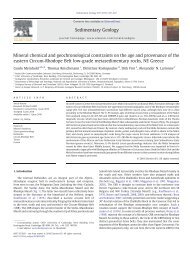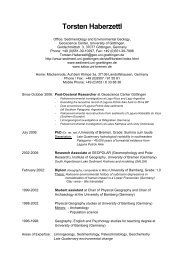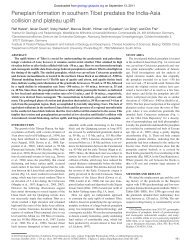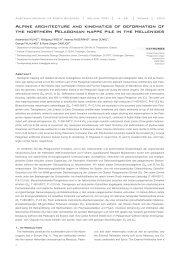Lecture Notes on Compositional Data Analysis - Sedimentology ...
Lecture Notes on Compositional Data Analysis - Sedimentology ...
Lecture Notes on Compositional Data Analysis - Sedimentology ...
Create successful ePaper yourself
Turn your PDF publications into a flip-book with our unique Google optimized e-Paper software.
8 Chapter 2. Sample space<br />
The first two cases yield final masses of [53, 76, 14] gr, respectively [28, 41, 8] gr. In a<br />
purely compositi<strong>on</strong>al data set, we do not know if we added or subtracted mass from<br />
the sandst<strong>on</strong>e to the sand. Thus, we cannot decide which of these cases really occurred.<br />
Without further (n<strong>on</strong>-compositi<strong>on</strong>al) informati<strong>on</strong>, there is no way to distinguish<br />
between [53, 76, 14] gr and [28, 41, 8] gr, as we <strong>on</strong>ly have the value of the sand<br />
compositi<strong>on</strong> after closure. Closure is a projecti<strong>on</strong> of any point in the positive orthant<br />
of D-dimensi<strong>on</strong>al real space <strong>on</strong>to the simplex. All points <strong>on</strong> a ray starting at the<br />
origin (e.g., [53, 76, 14] and [28, 41, 8]) are projected <strong>on</strong>to the same point of S D (e.g.,<br />
[37, 53, 10]%). We say that the ray is an equivalence class and the point <strong>on</strong> S D a representant<br />
of the class: Figure 2.2 shows this relati<strong>on</strong>ship. Moreover, if we change the<br />
Figure 2.2: Representati<strong>on</strong> of the compositi<strong>on</strong>al equivalence relati<strong>on</strong>ship. A represents the original<br />
sandst<strong>on</strong>e compositi<strong>on</strong>, B the final sand compositi<strong>on</strong>, F the amount of each part if feldspar was added<br />
to the system (first hypothesis), and Q the amount of each part if quartz was depleted from the system<br />
(sec<strong>on</strong>d hypothesis). Note that the points B, Q and F are compositi<strong>on</strong>ally equivalent.<br />
units of our data (for instance, from % to ppm), we simply multiply all our points by<br />
the c<strong>on</strong>stant of change of units, moving them al<strong>on</strong>g their rays to the intersecti<strong>on</strong>s with<br />
another triangle, parallel to the plotted <strong>on</strong>e.<br />
Definiti<strong>on</strong> 2.5. Two vectors of D positive real comp<strong>on</strong>ents x,y ∈ R D + (x i, y i ≥ 0 for all<br />
i = 1, 2, . . ., D), are compositi<strong>on</strong>ally equivalent if there exists a positive scalar λ ∈ R +<br />
such that x = λ · y and, equivalently, C(x) = C(y).<br />
It is highly reas<strong>on</strong>able to ask our analyses to yield the same result, independently of<br />
the value of λ. This is what Aitchis<strong>on</strong> (1986) called scale invariance:









